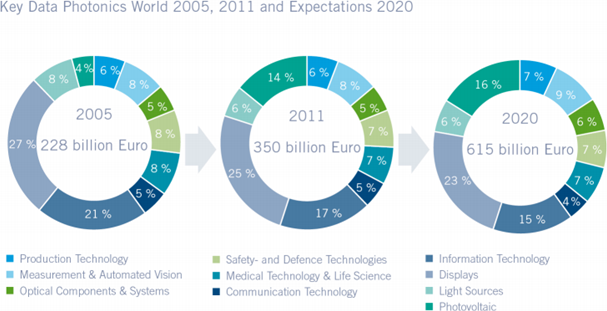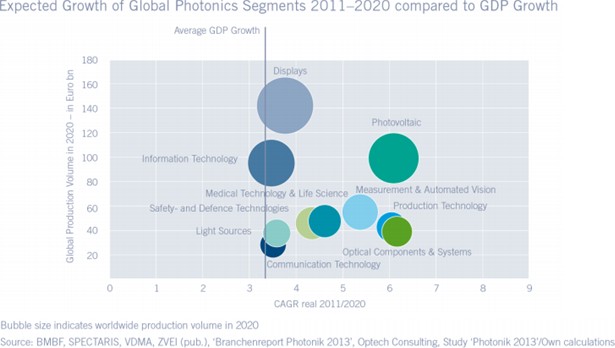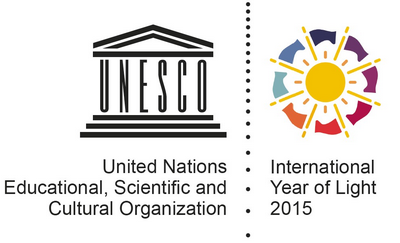Economic Impact
Businesses in the field of photonics and light-based technologies work on solving key societal challenges, such as energy generation and energy efficiency, healthy ageing of the population, climate change, and security. Photonic technologies have major impact on the world economy with a current global market of €300 billion and projected market value of over €600 billion in 2020. Growth in the photonics industry more than doubled that of the worldwide GDP (gross domestic product) between 2005 and 2011. This page will contain links and resources to let you learn about the important role that photonics plays in driving economic growth internationally.
2013 Photonics Industry Report
The Photonics Industry Report 2013, released by photonics21.org, highlights key industry metrics and changes from 2005 to 2020. It aims to show that the photonics industry is an increasingly important industry on both national and global scales.
Insights for worldwide photonics are shown below. View the downloadable PDF to see the full comprehensive report, including analysis by country and region.
Also view the Multiannual Strategic Roadmap towards 2020, including implementation timelines.
The graphic below shows the breakdown of the Photonics world market in 2005, 2011, and 2020, including segmentation by industry.

The graph below shows the expected global growth of different photonics segments from 2011 to 2020, and clearly shows that strong segments will continue to grow faster than average GDP.

The two following bar graphs show the prognosis for the growing impact of photonics on key manufacturing industries and key end-use industries in 2020 versus 2010.


EU Supporting Photonics (Horizon 2020):
With nearly €80 billion in funding available from 2014-2020, Horizon 2020 is the largest EU Research and Innovation programme ever. Horizon 2020 is the financial instrument implementing the Innovation Union, a Europe 2020 flagship initiative aimed at creating an innovation-friendly environment that creates economic growth and jobs in the EU. Through a Public Private Partnership (PPP), there is potential to implement in photonics in Horizon 2020. The overarching objectives in implementing a photonics PPP are to foster photonics manufacturing, job and wealth creation in Europe, accelerate Europe’s innovation process and time to market, and to mobilize public and private resources. This initiative would address market sectors where the European photonics industry is strong, including materials, equipment, component and devices, integrated systems, and products and solutions.
For more information on Horizon 2020 and Photonics PPP, utilize the following resources:
- Horizon 2020 + Photonics (PPP)
http://www.photonics21.org/download/News/PhotonicsandTOLAEinHorizon2020.pdf - Photonics21.org Downloadable Presentations
http://www.photonics21.org/downloads/download_presentations.php#38095 - 2013 Photonics Industry Report (Photonics21):
http://www.photonics21.org/download/Photonics_industry_report_2013/photonics_industry_report_2013.pdf
2014 Optics and Photonics Global Salary Report
Each year, SPIE conducts the Optics and Photonics Global Salary Survey, which is the largest survey of its kind in the global optics and photonics community. In February 2014, over 6,000 valid responses were gathered from 103 countries, providing data on the full breadth of employment and compensation patterns across regions, disciplines, and types of organizations.
Key findings of the 2014 survey are as follows:
- The median salary for survey respondents is $73,000. Salaries are widely distributed around this midpoint, with differences primarily driven by country income level and employer type.
- The highest-paid discipline is aerospace, with a median income of $116,269.
- For-profit respondents see product innovation as a key element of career success, versus academic and government respondents who place high value on scientific discovery.
- Survey respondents are highly satisfied with their jobs overall: 85% enjoy their work, while 88% respect the work of their peers.
- 40% of workers in higher-income Asian countries work 50 or more hours per week. 21% of Romanian workers report working 55 or more hours per week, the largest percentage of any country. Japan follows closely, with 20% working 55 hours or more per week.
- 91% of workers in lower-income Asian countries expect a raise in 2014 versus 58% of lower-income Europeans.
- Median salaries are 40% higher overall for men than for women, with the largest gap occurring late-career.

For more on the 2014 Optics and Photonics Global Salary Report, including segmentation by country, discipline, gender, and other factors, click here.

